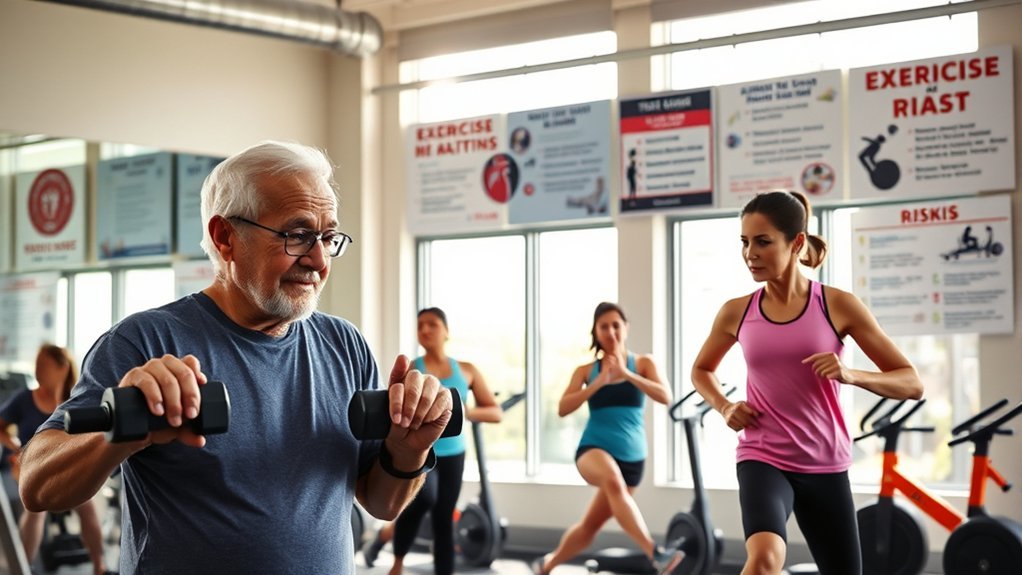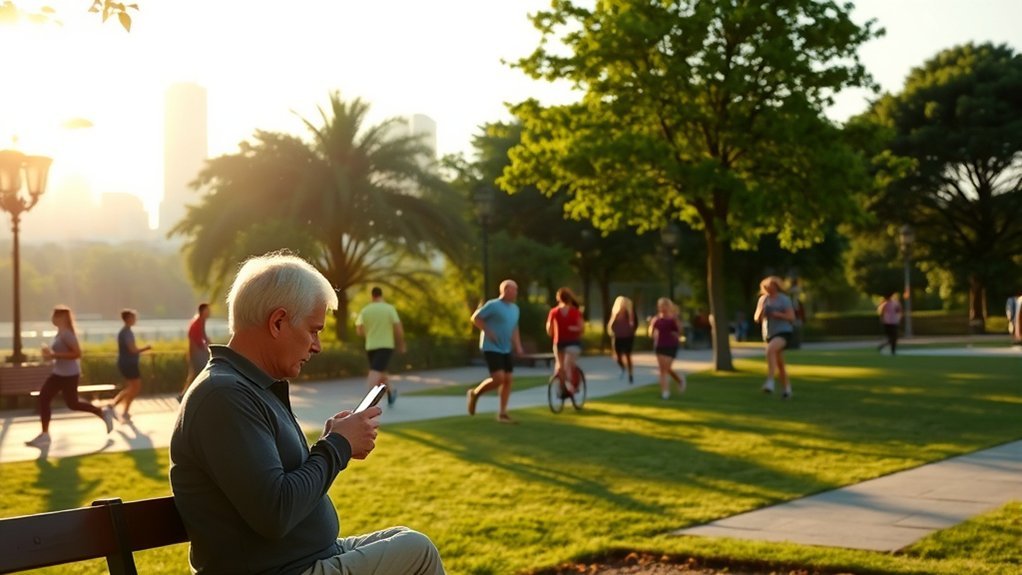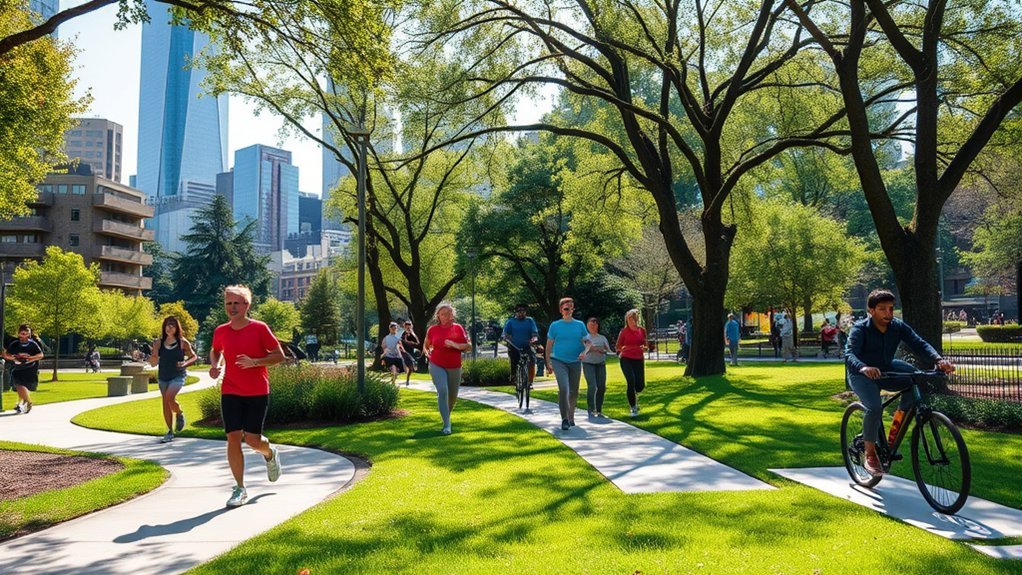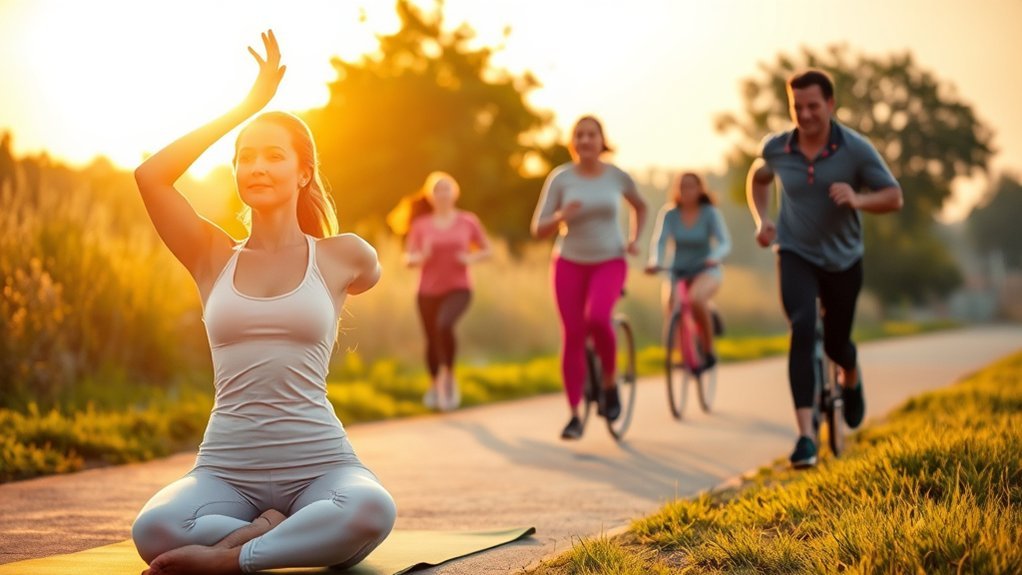Understanding the exercise guidelines in the U.S. reveals significant barriers that hinder many from meeting recommended activity levels. Sedentary lifestyles, driven by urban environments and socioeconomic factors, play a vital role in this issue. Limited access to recreational facilities and poor work-life balance further complicate the scenario. As you explore the multifaceted causes and risk factors, you’ll uncover the underlying complexities that contribute to our nation’s health challenges. What can be done to promote more active lifestyles?
Understanding Exercise Guidelines in the US

When you consider the importance of physical activity for overall health, understanding the exercise guidelines in the US becomes vital.
The Department of Health and Human Services recommends adults engage in at least 150 minutes of moderate-intensity aerobic activity each week, alongside muscle-strengthening exercises on two or more days.
Adults should aim for 150 minutes of moderate aerobic activity weekly, plus muscle-strengthening exercises twice a week.
This balanced approach not only improves cardiovascular health but also enhances mental well-being and reduces the risk of chronic diseases.
You should aim to achieve a mix of aerobic and strength training activities tailored to your abilities.
Staying consistent with these guidelines can yield significant health benefits, fostering a more active lifestyle and promoting longevity.
Adhering to these recommendations is essential for maintaining ideal health and well-being throughout your life.
The Impact of Sedentary Lifestyles

Sedentary lifestyles greatly increase your risk of chronic health issues, including obesity, diabetes, and cardiovascular diseases.
Research shows that prolonged inactivity can lead to detrimental effects on both physical and mental well-being.
Understanding these risks underscores the importance of finding effective solutions to counteract sedentary behavior in your daily life.
Health Risks Associated
Although modern conveniences and technology have made life more comfortable, they’ve also led to a significant rise in sedentary lifestyles, posing serious health risks. Prolonged inactivity can increase your likelihood of obesity, cardiovascular diseases, and type 2 diabetes. Understanding these risks is vital in addressing the impact of inactivity on your health.
| Health Risk | Description | Statistics |
|---|---|---|
| Obesity | Excess weight due to low physical activity | Affects 42.4% of adults |
| Cardiovascular Disease | Heart issues linked to sedentary behavior | Leading cause of death |
| Type 2 Diabetes | Insulin resistance from inactivity | 1 in 10 adults affected |
| Mental Health Issues | Anxiety and depression correlation | 25% report symptoms |
Solutions for Sedentary Behavior
To combat the detrimental effects of a sedentary lifestyle, incorporating regular physical activity into your daily routine is essential.
Research shows that even small changes can greatly improve your health. Here are three effective solutions to reduce sedentary behavior:
- Set Timers: Use a timer to remind yourself to stand up and move every hour. Short breaks can boost your energy and productivity.
- Active Commuting: If possible, walk or cycle to work instead of driving. This not only increases your activity level but also improves your mental well-being.
- Engage in Hobbies: Find activities you enjoy that involve movement, such as dancing, gardening, or playing sports. Enjoyable activities make it easier to stick to a more active lifestyle.
Taking these steps can lead to a healthier, more active life.
Urban Environments and Physical Activity

As urban environments continue to grow and evolve, they play an essential role in shaping physical activity patterns among residents.
In densely populated areas, you may find more opportunities for walking, biking, and outdoor recreation. Research shows that well-designed urban spaces, featuring parks and pedestrian pathways, can increase physical activity levels.
Conversely, urban settings often present challenges like traffic congestion and a lack of green spaces, which can discourage exercise. Additionally, safety concerns in certain neighborhoods may limit your willingness to engage in outdoor activities.
Understanding these dynamics helps you recognize how urban planning impacts your daily choices and overall health. By advocating for better infrastructure, you can contribute to creating environments that promote active lifestyles.
Socioeconomic Challenges Affecting Exercise
Income inequality greatly impacts your ability to access exercise facilities, which can hinder regular physical activity.
Often, those with lower incomes lack nearby options for affordable gyms or safe outdoor spaces, making it harder to maintain an active lifestyle.
Understanding these socioeconomic challenges is essential for developing effective exercise guidelines that promote inclusivity and accessibility.
Income Inequality Impact
While many endeavor to maintain a healthy lifestyle through regular exercise, significant barriers arise from income inequality that can hinder access to fitness opportunities.
Limited financial resources often restrict your ability to engage in physical activities, leading to disparities in health outcomes. Understanding these challenges can help you navigate this complex landscape:
- Cost of Gyms: Membership fees can be prohibitive, especially in low-income areas where affordable options mightn’t be available.
- Access to Equipment: Without the means to purchase or access proper exercise equipment, maintaining a workout routine becomes difficult.
- Safe Environments: Low-income neighborhoods may lack safe spaces for outdoor exercise, limiting your options for physical activity.
Addressing these disparities is essential for promoting equitable health solutions and enhancing overall community well-being.
Access to Facilities
Access to fitness facilities plays an essential role in your ability to engage in regular exercise, yet socioeconomic challenges can create significant barriers. Many individuals face limited access to gyms, parks, and recreational areas, which can hinder their motivation and ability to maintain a fitness routine.
| Barriers | Impact on Exercise |
|---|---|
| Cost of membership | Reduces participation |
| Distance to facilities | Limits accessibility |
| Lack of public transport | Hinders regular visits |
| Safety concerns | Deters outdoor activities |
Research shows that those in lower-income neighborhoods often have fewer recreational resources, leading to higher obesity rates and lower physical activity levels. Addressing these disparities is vital for improving community health outcomes.
Access to Recreational Facilities
Having convenient access to recreational facilities is essential for promoting physical activity and overall well-being.
When you have nearby options for exercise, you’re more likely to engage in regular physical activity. Research shows that access to recreational facilities can markedly reduce barriers to exercise.
Here are three key benefits of having these facilities close by:
- Increased Participation: Proximity encourages you to take part in sports, fitness classes, and community events.
- Improved Mental Health: Regular access to recreational spaces can enhance mood and reduce stress levels.
- Social Interaction: Facilities often serve as social hubs, allowing you to connect with others who share similar fitness goals.
In short, easy access to recreational facilities can positively influence your health and lifestyle choices.
Cultural Attitudes Towards Fitness
The availability of recreational facilities considerably shapes cultural attitudes towards fitness and exercise. In communities where gyms, parks, and sports complexes are easily accessible, you’re more likely to see a positive outlook on physical activity. Research indicates that these environments foster a culture where fitness becomes a social norm, encouraging participation across various demographics.
Conversely, in areas lacking such facilities, fitness may be perceived as less important or even unattainable, leading to higher rates of sedentary behavior. Additionally, media representations of fitness, often idealized, can create unrealistic expectations, impacting your motivation.
Understanding these cultural influences is vital; they not only affect individual choices but also shape community health outcomes and overall well-being.
Work-Life Balance and Exercise Habits
Balancing work and personal life can considerably influence your exercise habits, often determining whether you prioritize fitness or succumb to a sedentary lifestyle.
Balancing work and personal life significantly impacts your exercise habits, shaping your commitment to fitness or a sedentary lifestyle.
A well-structured work-life balance is essential for maintaining physical activity, as it can reduce stress and enhance your overall well-being.
Here are three ways you can improve your exercise habits:
- Set a Schedule: Designate specific times for workouts within your weekly calendar to guarantee you commit to them.
- Incorporate Movement: Look for opportunities to be active during your workday, such as taking short breaks to stretch or walk.
- Establish Boundaries: Limit work hours to prevent burnout and create space for personal time dedicated to fitness.
Technology’s Role in Physical Activity
In today’s fast-paced world, technology plays an essential role in promoting physical activity.
Digital fitness apps and wearable activity trackers provide real-time feedback and personalized goals, making it easier for you to stay motivated.
Additionally, online workout communities foster support and accountability, encouraging you to maintain an active lifestyle.
Digital Fitness Apps
Digital fitness apps have transformed how you approach physical activity, offering a variety of tools designed to enhance your workouts and track your progress.
These apps cater to different fitness levels and goals, making exercise more accessible and enjoyable. Here are three ways digital fitness apps can benefit you:
- Personalized Workouts: Many apps create tailored exercise plans based on your fitness level, preferences, and goals, ensuring you stay engaged.
- Progress Tracking: You can monitor your improvements over time, which boosts motivation and accountability.
- Community Support: Many apps feature social components, allowing you to connect with others, share achievements, and participate in challenges, fostering a sense of belonging.
Leveraging these features can help you optimize your fitness journey effectively.
Wearable Activity Trackers
As you embrace innovative tools like digital fitness apps, wearable activity trackers emerge as another key component in enhancing your physical activity regimen.
These devices monitor your steps, heart rate, and overall activity levels, providing real-time feedback that can motivate you to achieve your fitness goals. Research shows that individuals using wearable trackers are more likely to engage in regular physical activity, as they foster accountability and awareness.
By setting personalized targets, you can track your progress and make informed adjustments to your routine. Moreover, many trackers offer features like sleep analysis and reminders to stay active, enhancing your overall wellness.
Incorporating a wearable activity tracker into your life can greatly support your commitment to a healthier lifestyle.
Online Workout Communities
While you may find it challenging to stay motivated alone, online workout communities provide an effective solution by fostering a sense of accountability and camaraderie.
These platforms connect you with like-minded individuals, enhancing your commitment to fitness. Research shows that social support greatly boosts exercise adherence, making these communities invaluable.
Here are three key benefits of joining an online workout community:
- Motivation: Regular interaction with others can inspire you to push through tough workouts.
- Resource Sharing: You gain access to diverse workout plans, nutrition advice, and expert tips from fellow members.
- Progress Tracking: Many communities offer tools to monitor your achievements, helping you stay focused on your fitness goals.
Engaging in these communities can transform your exercise routine into a more enjoyable and rewarding experience.
Health Disparities and Their Effects
Health disparities greatly impact individuals’ ability to engage in regular exercise, particularly among marginalized communities. Factors such as socioeconomic status, access to safe recreational spaces, and availability of affordable fitness resources play significant roles.
For instance, you might find that low-income neighborhoods often lack parks or fitness facilities, making it challenging to stay active. Additionally, cultural attitudes and systemic barriers can discourage participation in exercise programs.
Research indicates that these disparities lead to higher rates of obesity, chronic diseases, and mental health issues among affected populations. Without addressing these inequities, promoting a healthier lifestyle becomes increasingly difficult.
Understanding these impacts is essential for fostering inclusive approaches to exercise and wellness in all communities.
Strategies for Promoting Active Lifestyles
To effectively promote active lifestyles, communities must implement targeted strategies that address specific barriers to physical activity.
Research shows that environmental, social, and economic factors influence individuals’ willingness to engage in physical activity.
Here are three effective strategies:
- Enhance Access: Develop safe, accessible parks and recreational facilities to encourage outdoor activities.
- Community Engagement: Organize group fitness classes or walking clubs, fostering a sense of belonging while motivating individuals to stay active.
- Education and Awareness: Provide workshops on the benefits of physical activity, addressing misconceptions and highlighting local resources.
Frequently Asked Questions
What Are the Recommended Exercise Durations for Different Age Groups?
For children and teens, aim for at least 60 minutes of daily activity. Adults should target 150 minutes of moderate-intensity or 75 minutes of vigorous-intensity exercise weekly, while older adults should include balance activities too.
How Do Exercise Guidelines Differ for People With Disabilities?
Just as a river carves its path through varied landscapes, exercise guidelines for people with disabilities adapt to individual needs. They emphasize tailored activities, ensuring safety and promoting health, enhancing overall well-being and quality of life.
Are There Specific Exercises for Maintaining Mental Health?
Yes, specific exercises like yoga, tai chi, and aerobic workouts can greatly boost mental health. Engaging in these activities regularly helps reduce anxiety, depression, and stress, enhancing your overall emotional well-being and cognitive function.
What Role Does Nutrition Play in Exercise Effectiveness?
Nutrition’s the fuel that powers your workouts; without it, you’re like a car running on empty. Proper nutrients enhance muscle recovery, boost energy levels, and improve overall performance, making your exercise sessions more effective and rewarding.
How Can I Stay Motivated to Follow Exercise Guidelines Consistently?
To stay motivated, set specific, achievable goals, track your progress, mix up your routine, and find a workout buddy. Celebrating small victories and reminding yourself of the benefits will keep you engaged and committed.
Conclusion
In weaving the fabric of healthier communities, it’s essential to address the tangled threads of sedentary lifestyles, socioeconomic barriers, and cultural perceptions. By shining a light on these challenges, we can craft tailored strategies that inspire activity and foster well-being. As you navigate your own path to fitness, remember that small, consistent steps can lead to significant change. Together, let’s break down the walls of inactivity and build a vibrant landscape where everyone can thrive in movement.
